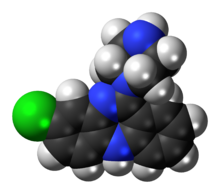Desmethylclozapine
 | |
 | |
| Clinical data | |
|---|---|
| Routes of administration | Oral |
| ATC code |
|
| Legal status | |
| Legal status |
|
| Identifiers | |
| |
| CAS Number | |
| PubChem CID | |
| IUPHAR/BPS | |
| ChemSpider | |
| UNII | |
| ChEMBL | |
| CompTox Dashboard (EPA) | |
| ECHA InfoCard | 100.164.220 |
| Chemical and physical data | |
| Formula | C17H17ClN4 |
| Molar mass | 312.80 g·mol−1 |
| 3D model (JSmol) | |
| |
N-Desmethylclozapine (NDMC), or norclozapine, is a major active metabolite of the atypical antipsychotic drug clozapine.[1][2]
Unlike clozapine, it possesses intrinsic activity at the D2/D3 receptors, and acts as a weak partial agonist at these sites similarly to aripiprazole and bifeprunox.[3] Notably, NDMC has also been shown to act as a potent and efficacious agonist at the muscarinic acetylcholine M1 receptor and the δ-opioid receptor, unlike clozapine as well.[4][5][6] It is a moderate-efficacy partial agonist of the muscarinic acetylcholine M1 and M2 receptors, a very weak partial agonist or antagonsit of the M3 receptor, and a silent antagonist of the M4 receptor.[7] It also binds with high affinity to the M5 receptor, but its intrinsic activity was not reported for this receptor.[7]
It was hypothesized that on account of its unique actions, NDMC might underlie the clinical superiority of clozapine over other antipsychotics. However, clinical trials found NMDC itself ineffective in the treatment of schizophrenia.[8][9] This may be because it possesses relatively low D2/D3 occupancy compared to the 5-HT2 receptor (<15% versus 64–79% at a dose of 10–60 mg/kg s.c. in animal studies).[10]
Albeit not useful in the treatment of positive symptoms on its own, it cannot be ruled out that NDMC may contribute to the efficacy of clozapine on cognitive and/or negative symptoms.[8]
See also
References
- ^ Lovdahl MJ, Perry PJ, Miller DD (January 1991). "The assay of clozapine and N-desmethylclozapine in human plasma by high-performance liquid chromatography". Therapeutic Drug Monitoring. 13 (1): 69–72. doi:10.1097/00007691-199101000-00010. PMID 2057995.
- ^ Bablenis E, Weber SS, Wagner RL (February 1989). "Clozapine: a novel antipsychotic agent". DICP: The Annals of Pharmacotherapy. 23 (2): 109–15. doi:10.1177/106002808902300201. PMID 2658370. S2CID 36582093.
- ^ Burstein ES, Ma J, Wong S, et al. (December 2005). "Intrinsic efficacy of antipsychotics at human D2, D3, and D4 dopamine receptors: identification of the clozapine metabolite N-desmethylclozapine as a D2/D3 partial agonist". The Journal of Pharmacology and Experimental Therapeutics. 315 (3): 1278–87. doi:10.1124/jpet.105.092155. PMID 16135699. S2CID 2247093.
- ^ Weiner DM, Meltzer HY, Veinbergs I, et al. (December 2004). "The role of M1 muscarinic receptor agonism of N-desmethylclozapine in the unique clinical effects of clozapine". Psychopharmacology. 177 (1–2): 207–16. doi:10.1007/s00213-004-1940-5. PMID 15258717. S2CID 1024531.
- ^ Li Z, Huang M, Ichikawa J, Dai J, Meltzer HY (November 2005). "N-desmethylclozapine, a major metabolite of clozapine, increases cortical acetylcholine and dopamine release in vivo via stimulation of M1 muscarinic receptors". Neuropsychopharmacology. 30 (11): 1986–95. doi:10.1038/sj.npp.1300768. PMID 15900318.
- ^ Olianas MC, Dedoni S, Ambu R, Onali P (April 2009). "Agonist activity of N-desmethylclozapine at delta-opioid receptors of human frontal cortex". European Journal of Pharmacology. 607 (1–3): 96–101. doi:10.1016/j.ejphar.2009.02.025. PMID 19239909.
- ^ a b Sur C, Mallorga PJ, Wittmann M, Jacobson MA, Pascarella D, Williams JB, Brandish PE, Pettibone DJ, Scolnick EM, Conn PJ (November 2003). "N-desmethylclozapine, an allosteric agonist at muscarinic 1 receptor, potentiates N-methyl-D-aspartate receptor activity". Proc Natl Acad Sci U S A. 100 (23): 13674–13679. doi:10.1073/pnas.1835612100. PMC 263872. PMID 14595031.
- ^ a b Bishara D, Taylor D (2008). "Upcoming agents for the treatment of schizophrenia: mechanism of action, efficacy and tolerability". Drugs. 68 (16): 2269–92. doi:10.2165/0003495-200868160-00002. PMID 18973393. S2CID 42020114.
- ^ Mendoza MC, Lindenmayer JP (2009). "N-desmethylclozapine: is there evidence for its antipsychotic potential?". Clinical Neuropharmacology. 32 (3): 154–7. doi:10.1097/WNF.0b013e31818d46f5. PMID 19483482. S2CID 24544110.
- ^ Natesan S, Reckless GE, Barlow KB, Nobrega JN, Kapur S (July 2007). "Evaluation of N-desmethylclozapine as a potential antipsychotic--preclinical studies". Neuropsychopharmacology. 32 (7): 1540–9. doi:10.1038/sj.npp.1301279. PMID 17164815.
